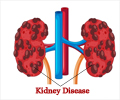Use of blood levels of cystatin C to estimate kidney function strengthens the association between kidney function and risks of death and end-stage renal disease.

Kidney function estimates are central to the diagnosis and management of chronic kidney disease, and these estimates are usually based on the creatinine blood test. However, the creatinine test can miss early losses of kidney function, particularly in patients with low muscle mass.
Cystatin C, a newer kidney function marker, is becoming more widely available and in some settings provides improved estimates of kidney function.
For the study, the researchers performed a meta-analysis of 11 general-population studies (with 90,750 participants from the United States, Europe and Australia) and five studies of participants with chronic kidney disease (2,960 participants) for whom standardized measurements of serum creatinine and cystatin C were available. They compared the association of kidney function, as calculated by the measurement of creatinine, cystatin C, or the combination of creatinine and cystatin C, with the rates of death, death from cardiovascular causes, and end-stage kidney disease, and they compared kidney disease stages that were classified alternatively by creatinine or cystatin C.
Results of the analyses using cystatin C demonstrated that the risks associated with declining kidney function emerge when kidney function reaches approximately 85 ml per minute per 1.73 m2, much earlier than the threshold of chronic kidney disease (i.e., 60 ml/min/1.73m2). In contrast, with creatinine based kidney function estimates, these risks of kidney function cannot be observed until kidney function is below 60 ml/min/1.73m2 by which time chronic kidney disease has already developed. The kidney function stages categorized by cystatin C were much better at reflecting future risk than were the stages based upon creatinine estimates of kidney function.
“Clearly cystatin C defines an important preclinical period of reduced kidney function before chronic kidney disease can be diagnosed with creatinine alone, and this period may last one to two decades,” said Michael Shlipak, MD, MPH, lead author of the article and chief of general internal medicine at the San Francisco VA Medical Center. Shlipak also is a professor of medicine, epidemiology and biostatistics at UCSF. “Cystatin C allows patients’ kidney function to be categorized more accurately; the use of cystatin C in clinical medicine could help us to be more precise in the diagnosis of chronic kidney disease, and in the future to target high-risk patients for treatment in order to prevent chronic kidney disease.”
Advertisement
“Accurate detection and staging of chronic kidney disease are integral components of clinical medicine, since such evaluations have a major effect on disease labeling, interventions, drug doses, and risk stratification for clinical procedures,” said Josef Coresh, MD, PhD, the Consortium’s principal investigator and professor in the Johns Hopkins Bloomberg School’s Department of Epidemiology. “Our study provides definitive evidence that the measurement of cystatin C improves risk categorization based on estimated kidney function, as judged by the risk of death from any cause and to a lesser extent the risks of death from cardiovascular causes and end-stage kidney disease.”
Advertisement
Source-Eurekalert















